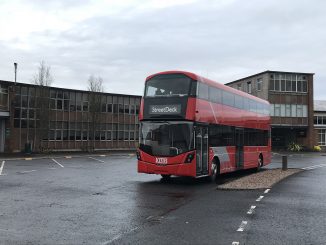Tri-axle Dennis Dragons given a public farewell
HONG KONG
Hong Kong’s largest franchised bus operator, KMB (Kowloon Motor Bus) withdrew its final bus with ‘3+2’ seating arrangement on Wednesday, June 25.
At a farewell ceremony, a KMB engineer and bus captain shared with the public the features of the ‘3+2’ buses and their memories of operating such buses, recognising the contribution they made to the bus industry.
The last 10m Dennis Dragons have latterly been allocated to the firm’s rural and feeder routes thanks to their flexibility and higher carrying capacity compared to other 10m double-deckers. The routes included 64K Yuen Long (West) – Tai Po Market Railway Station, 15A Ping Tin – Tsz Wan Shan (North) and 80M Sui Wo Court – Kowloon Tong Railway Station. On their final day in service, three Dragons operated on service 80M.
Prior to the 1970s, the ‘2+2’ seating layout was adopted as conductors needed room in which to perform their duties. In 1974, the ‘3+2’ seating layout in the form of foam-cushioned bench seats was first introduced on Daimler Fleetlines which operated with coin-collecting boxes. While the seat was wide enough for three passengers to occupy, the space to be taken up by a single passenger was not specified. The seating layout was welcomed as it raised the bus capacity, meeting the needs of some busy routes with high passenger demand. The layout was subsequently used on a number of non air-conditioned bus models, including MCWs, Leyland Victory II, Leyland/Volvo Olympians and Dennis Dragons.
Air-conditioning became more and more popular on different types of public transport as Hong Kong’s economy started to take off and customer expectations changed.
Following successful trials in the 1980s, KMB introduced batches of air-conditioned double-decker tri-axles in the 1990s, including Leyland Olympians and Dennis Dragons, leading KMB into the era of air-conditioned buses.
To tie in with the luxurious image, KMB introduced the ‘3+2’ individual seat design on the upper deck, with a width of 380mm for each seat, a breakthrough which reflected KMB’s response to passengers’ desire for more comfortable bus journeys.
As passengers’ body sizes increased, from 1995 the width of most seats was widened to 410mm for all new buses purchased by KMB (and further widened to 440mm from 2002).
At the same time, passengers were able to enjoy greater comfort with the introduction of the ‘2+2’ seating layout on both decks, which resulted in increased width in both seats and ailes. In addition, from 1997, headrests were added, providing better support for the passenger’s neck.
“While many passengers prefer the comfort provided by the ‘2+2’ layout, some families like the ‘3+2’ seating arrangement, as three people can chat away in this configuration,” said bus captain Wu Kai-ho, who has driven buses with the ‘3+2’ layout for many years.
According to So Hing-shun, KMB’s Assistant Principal Engineer (Operations): “Over the years KMB engineers have been working with suppliers to optimise the arrangement and design of bus seats and strike a balance between bus capacity and passenger comfort. Since 1990, we have introduced seats with leatherette and high-density emulsion cushions. The newest generation of seats introduced in 2013 saw the height of the seatback including headrest increased to 640-730mm.
“Furthermore, there is a reclining angle of no less than 105 degrees between the seatback and the cushion. The ergonomic design of the seat contour, the headrest and the seatback inclination angle means that the new seats provide excellent support to passengers.”



